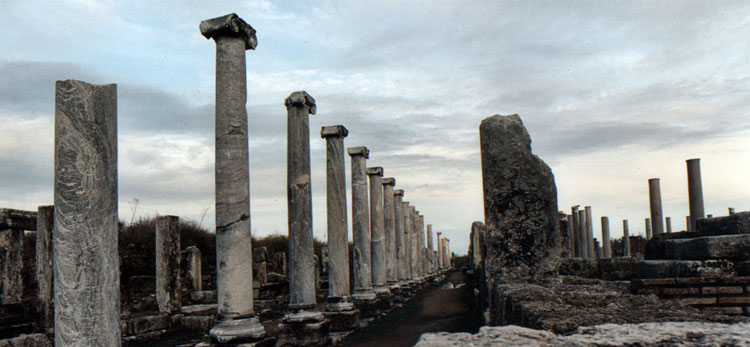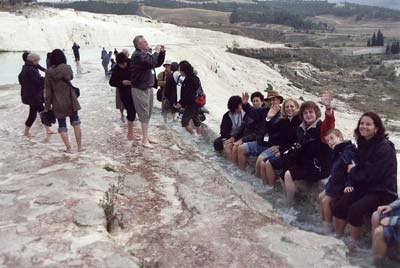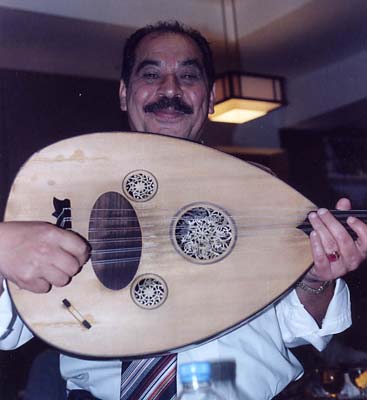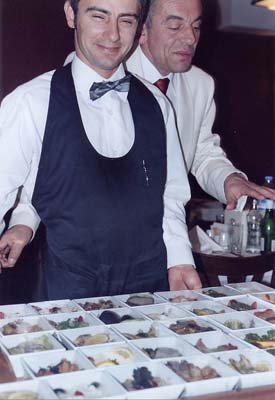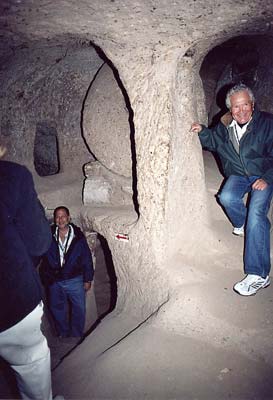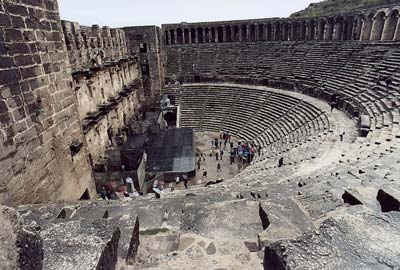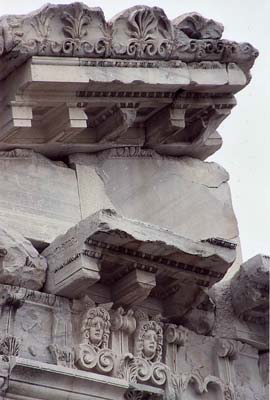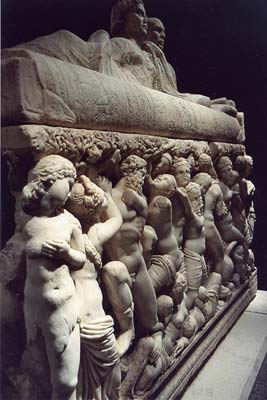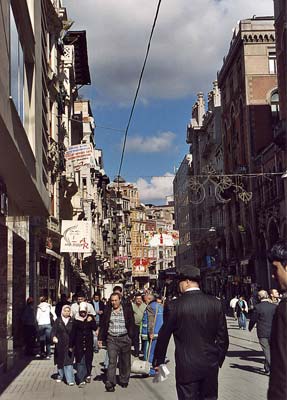Cones, caves and capstones — Cappadocia plus more in Turkey
by David Tykol, Editor
Our bus parked at the lip of the valley and everyone gasped. Looking out at a landscape of bleached-tan earth nearly devoid of green grass or vegetation, we saw hundreds of giant cones and pillars — like 3-story-tall termite mounds tinged in yellows and reds — that seemed to be piercing through the ground skyward. Surrounding this were undulating cliffsides and rock masses. The scene was both beckoning and foreboding.
Three million years ago, the region of Cappadocia in central Turkey was blanketed in ash and lava laid down by multiple eruptions of two now-extinct volcanoes. The resulting layers of rock and various mineral oxides slowly eroded away at different rates, leaving stalagmite-like formations, some capped mushroom-like with basalt rock.
The tuff comprising these more than 100 square miles is porous and easily carved, hardening upon exposure to air. Consequently, many of the pillar “fairy chimneys” and the surrounding hillsides and cliffs are peppered with holes and caves, none of which are natural; all have been carved out by people. There are thousands of rock-walled rooms in this region, even the remains of whole towns underground.
Life in an ant farm
My visit to Cappadocia (pronounced cap-uh-DO-kee-uh) was part of a familiarization tour of Turkey, Oct. 26-Nov. 7, 2006, with FLO USA, Inc. (Lake Mary, FL; 888/435-6872). For years I had wanted to see Cappadocia’s unique volcanic terrain, and, while the valleys were not as expansive as I had envisioned, I was not disappointed.
Anatolia, or Asia Minor, now the greater part of Turkey surrounded by the Black, Aegean and Mediterranean seas, has been occupied by many civilizations: Hittites, Persians, Arabs, Mongols, Ottomans, Romans…. There were monastic settlements in central Anatolia in the fourth century, including in Cappadocia, and when Arabs invaded in the seventh and eighth centuries, Christians joined the local monks in seeking refuge underground.
Members of our tour group explored Kaymaklı, one of the now-abandoned underground towns, south of Nevs¸ehir. It could comfortably house thousands of people out of sight for up to a month. We walked down five stories out of the eight levels it extends underground like an ant farm and were shown where people slept, worshiped, stored water and food, kept livestock, made wine and even kept the dead (they were in hiding, remember).
To me, it was exciting following the branching tunnels and stairways. Some passageways were quite tight, and on our path one 15- to 20-foot section required bending over and inching along — an effort even for me, and I’m short, though one senior member of our group, stocky, over six feet tall and with two new knees, also made it through. What impressed me was how the many interconnected rooms were designed with sight lines as long as possible and a sense of openness.
The rooms and stairwells we toured were well lit. I had expected loose dirt underfoot, but the passages seemed mostly swept clean. Floors and walls weren’t slippery but rough, like bumpy stucco. I tried to imagine the place full of sound, with colorful fabrics on the walls and floors, but I just saw stony gray.
Half a dozen in our group preferred to stay aboveground while the rest of us toured. And another whole tour group backtracked past ours after becoming claustrophobic — unusual, our guide said.
Dozens of these underground cities were scraped out, most by Christians from the sixth to 14th centuries. One of the remaining mysteries involves the air and smoke vents. They extend off for hundreds of yards in different directions so as not to give away the occupants’ exact location, but they are too small for even a child to squeeze into, so how were they carved?
We also visited Göreme Open-Air Museum with its cave churches, a few of more than 600 in the area. The rooms vary in size, some with the carved equivalents of vaulted naves, apses and pillared aisles — all for show, not structural support. Many have Byzantine frescoes depicting scenes from the Old and New Testaments, though the faces of several of the figures have been obliterated.
Today, townspeople in the area still live and work in many hillside and underground caves (in addition to more modern aboveground buildings).
By the way, of the many souvenir stands we came across at tourist sites throughout Turkey, our guide correctly informed us that the ones just below the Göreme Open-Air Museum had the lowest prices on the same good-quality crafts, including pashmina scarves (YTL6, or $4.50) and intricate lace doilies and antimacassars (YTL5 and up).
Pack an appetite
Our circle tour of western Turkey took us from metropolitan Istanbul (14 million people) south to Çanakkale (for the Troy excavations), ancient Pergamum and Kusadasi (for Ephesus), southeast to Antalya (including Perge), northeast to Konya and Cappadocia, then north to Ankara, west to Bursa and north back to the capital — a total of over 2,300 miles.
It was fall and, while we mostly had clear skies and could get by wearing light jackets, we had brief rain at Ephesus, felt chilly in Çanakkale, had to cancel our hot-air balloon ride ($160) over Cappadocia because it was socked in by fog that morning, saw flooding around Antalya and got snowed on one day in Ankara.
We passed orange groves (fresh-squeezed juice was available at some rest stops — YTL4), saw sugar beets being harvested and identified sesame drying in fields. Hills were turning green, and the many farmlands we passed were patchworks of green, gold and brown. Turkey grows enough produce and raises enough livestock to feed itself. The produce and spice markets were brimming.
After the first few days, I stopped worrying whether the food was going to be any good and started looking forward to every meal. Whether you are a vegetarian or, like me, a meat needer, you will find something to savor wherever you go.
The hotels in which our group stayed all had buffets for breakfast and dinner. The vast arrays included sliced meats and cheeses, cold dishes of yogurts, dolmas, artichokes, halva or sesame-seed paste and hot dishes of beef, lamb, chicken or fish, not to mention a number of syrupy and chocolatey desserts.
What surprised me was how good the food was at plain, old trucker-and-tourist stops far from big cities. We would go through a cafeteria line and point at what we wanted — meatballs, fish, eggplant, beans, potatoes — and more often than not it would be down-home delicious, spiced for flavor not for hotness. Our lunches ran YTL8-14 ($6-$10.50) plus tip.
My favorite meal was the lunch buffet at the Kardesler Restaurant (2 Ihsan Özissi, Maltepe Mh. Atatürk Bulvari No:49, Bergama/Izmir, Turkey; phone 6313342) at Bergama, near the Asclepion. I especially loved the meatballs, and the eggplant dishes there were the best I ever have eaten. Lunch cost YTL10 plus drinks.
Our guide mentioned that, in general, the steaks in Turkey are not so good; they’re thin, and the chefs don’t understand “rare” or “medium rare.”
Greek and Roman legacies
As the many cruise passengers who have visited Ephesus know, Turkey has a number of ruins — in fact, more ancient Greek ruins than Greece and more ancient Roman ruins than Italy.
Of the Roman sites we visited, most of what is left are foundation stones, marble columns, marble friezes, stone-block walls and a few arches. But each place also seemed to have one or more whole amphitheaters, several of which are still in use and all of which are visually impressive and fun to climb around on.
At sites of ancient Pergamum, around present-day Bergama, I enjoyed walking through the arched stone-and-brick tunnels of the Asclepion, once a medical center. On a high rise overlooking the city, the Pergamum Acropolis, spiked with pillars and strewn with carved marble pieces, also was fun to explore. There was a great number of steps to climb here.
About 10 miles east of Antalya is Perge (pronounced pair-gay) with its remains of Hellenistic gate twin towers, a road of marble blocks lined with columns, and excavations revealing the brickworks for thermal baths. Much of this site was on level ground although not all wheelchair accessible.
About 30 miles southeast of Antalya, in Belkis, are the ruins of Aspendos, where we visited the well-preserved Roman theater built during the reign (A.D. 161-180) of Marcus Aurelius. It was designed to hold 12,000 people but at recent events has held up to 20,000. A few of the steps are 1_ feet high, and climbing to the top got my heart racing as well as my mind.
Except for Ephesus, there were not many people at any of these places during our visits.
At Ephesus, the often-pictured Celsius Library still has a couple of the marble statues that patrons once looked up to, but the statues from most of these sites now stand in museums around the world.
At Perge, I was sad that I could only imagine how the column-lined road must have looked when each pillar was topped with a life-sized statue of a god, goddess or dignitary.
The marble statues, most now missing an appendage or two, really are beautiful works of art, and each expresses a personality, as we saw in the Antalya Museum (entry $7). At this spectacular exhibit space, not only can you take pictures (without flash), you can walk right up to within inches of ancient statues, carved sarcophagi and other marble pieces. Many have descriptions in both Turkish and English.
In Turkey’s second-biggest city, Ankara, the world-class Museum of Anatolian Civilizations ($7) is even larger and has a much wider scope. Only a small portion is devoted to the Roman era, however, so there are few marble statues, but the artwork, artifacts, pottery, weapons, etc., from throughout much of Turkey and the ages are beautifully chosen pieces. Many schoolchildren visit.
Neighborly people
Of the more than 71 million people in Turkey today, 99 percent are Muslim, but through the efforts of Mustafa Kemal, later known as Atatürk (1881-1938) — who founded the Republic of Turkey and is still revered — the government has remained staunchly secular, with the military stepping in several times to keep it that way, notably in 1960, 1971 and 1980. In the recent July 2007 elections, the party winning the majority of votes has Islamist roots, and many now are watching to see if the government will continue to keep church and state separate.
In Turkey there are no madrasahs (government-funded religious schools), women do not have to dress in any particular way and, in fact, women hold positions of stature and power. The forward-thinking Atatürk planted in the minds and souls of the people a tolerance for differing opinions and beliefs. However, there are restrictions. Reflecting the degrees of freedom in the country, one Turkish man told me, “You can walk down the street with a drink in your hand, but if you say bad things about the government you can get arrested.”
I felt completely comfortable among the people everywhere in Turkey. I laughed when a young vendor in Istanbul said, “Hello. Can I help spend your money?”
As our bus passed through the little town of Denizli on our approach to Pamukkale — the site of cascading travertine basins, deposits of white frosting-like limestone slowly built up from minerals in the hot springs — separately, two children and one young man waved at us. That was unusual, however. Most of the time the members of our group were simply treated by locals the same as everyone else — politely, matter-of-factly and with respect, even when they knew we were Americans. We weren’t stared at nor fawned over, and the souvenir hawkers did not harass us.
At the Ulu Mosque in Bursa, we had been told to remove our shoes before entering, as at any mosque, and the women each were instructed to cover their head with a scarf. We also were on our toes to remove our shoes in the proper place, making sure not to denigrate the entryway carpet and upset either of the gentlemen watching over us, so I was a bit on edge upon entering.
Inside, one of the men said to a woman in our group who had forgotten her head covering, “Madam, please cover your hair,” then smiled at her as she realized her goof and, flustered, quickly complied. His smile put her, and me, at ease.
In Istanbul we stayed in the Marmara Pera hotel downtown, only a block or so from Istiklal Caddesi, a bricked street lined with 5-story buildings housing apartments, shops, food outlets and nightspots. Though there are almost no places to sit, it’s great for people-watching, as it’s always busy.
A few of us went looking for the happening places there one night and learned that the jazz and blues music didn’t even start until 10 p.m. or midnight! On another evening I was taken to an area full of restaurants and nightclubs, Nevizade Street, and the restaurant Imroz Lokantasi (Nevizade Sokak 24 Beyoglu, Istanbul; phone 0212 249 90 73), where a traditional 4-piece band was playing, comprising an ud (like a guitar), flute, violin and dumbelek (like a bongo).
The restaurant gradually filled up with college-age kids who often broke into song and we all enjoyed selections of mezes (appetizers, at $6-$8 a dish) and wine, beer or raki (a sweet, anise-flavored liqueur you can mix with water). Exhilarating! (In restaurants priced at the low end, each meze can run $1-$2.)
What to expect
FLO USA offers customized tours and numerous competitively priced escorted tours, ranging from the 6-day/4-night “Magical Istanbul” ($1,147-$1,674 out of New York) to the 30-day/28-night “Grand Turkey” ($4,415-$5,966 from New York), with add-on fares from all over the U.S. starting at $160. Those 65 and over receive a $50 discount.
Not included in the price are visa fees, beverages (although each person gets up to three bottles of water on the bus each day) and gratuities for the tour guide, driver and luggage handlers. Anyone signing up for a tour automatically is enrolled in the FLO USA Protection Plan, offering a full refund for trip cancellation for practically any reason.
I flew Turkish Airlines in roomy business class out of New York and returned from Istanbul in coach and found both flights comfortable. The food in business was great (lamb) and in coach, so-so.
On our 13-day/11-night tour, more rushed than the regular tours, we stayed in eight different hotels. All were comfortable, some being quite modern and some a little older but with charm and warmth. All provided consistent hot water, TVs with CNN, and other comforts.
All but one of the beds I slept in had duvets; after I removed the heavy inside blanket, I found the covering comfortable. All the hotels’ bathrooms had fluffy towels, but only one supplied a washcloth.
At times I left a window open to cool the room. In smoggy Bursa, some in our group kept their windows closed. Many people and I had our best night’s sleep at the Radisson SAS in Ankara, but one quirk of its rooms is the glass window (only partially frosted) between the bed area and the shower and toilet. (What were they thinking?!)
At the marvelous Spa Hotel Colossae Thermal at Pamukkale, try the naturally heated pools of different temperatures. You’ll melt!
In our first hotel, a very modern structure in Istanbul, I assumed it was okay to drink the water, which I did to take a pill, since there were drinking cups by the bathroom sink and no special thermos or bottle of water there. (What was I thinking?!) At that evening’s welcome talk, however, we were told to not drink tap water in any of our hotels, even though all were 4- or 5-star. Luckily, I did not get sick at all.
On the road
Our tour comprised about 120 people on four buses, each with its own guide. (On regular escorted tours, there are no more than 16 passengers per bus and five buses maximum.) Each bus group toured on its own, only meeting at some mealtimes or at the hotel.
Our bus’ tour guide was Yes¸im Güris¸, who was highly knowledgeable and very well organized and shared personal stories of her life in Turkey — great insights. Of the other three buses in our tour, one group liked their guide a lot, one group’s guide had mixed reviews and the consensus of the fourth group was that their guide should have been more knowledgeable.
In addition to seeing ancient ruins and natural wonders, our group visited markets, 11th-century caravanserais, a carpet factory, a leather-goods shop, a ceramics shop, a jewelry store and more. At two of the major tourist sites — Hagia Sophia and the Topkapi Palace — visitors had to put their cameras, camera bags, purses, etc., through an x-ray machine.
I thought I would be wowed by the sixth-century Byzantine basilica Hagia Sophia in Istanbul, and it is impressive, but it was the nearby Sultan Ahmet Camii, or Blue Mosque, that took my breath away. I was not expecting such splendor. With colorful tiles, marble and mosaics and painted arabesque and floral designs, every square inch of it is beautiful.
Only a couple of days of our tour involved six or more hours of lengthy driving, but the bus was quite comfortable. Roads were paved and well signed. We made sufficient rest stops and found the bathrooms acceptable to very clean. (The women in our group were given a lesson in how to use the floor-level toilets they might sometimes encounter.)
At all highway rest stops there were bottled water and sodas and packaged snacks, cookies, candy and chips to buy plus, sometimes, fresh-cooked food. At the stop Seref Mola (Yolu Üzeri, Yazir, Korkuteli, Türkiye; phone 0 242 649 44 91-649 41 43), between Antalya and Pamukkale, I bought gözleme, simply a thin sheet of wheat pastry folded over with crumbly goat cheese and quickly heated on a griddle with oil while I waited — delicious and only two liras! The Turkish Delight “candy” being sold there was good too.
After every rest stop, someone would pass around a bag of flavored nuts or candy or some other surprise. We never went hungry.
Outside the bus window, the scenery was never marred by billboards except just outside of and within the cities. We passed small towns, farmland, seas and a salt lake and crossed the beautiful Taurus (Toros) Mountains (peaks up to 12,000 feet), their granite outcroppings at times reminding me of the Sierras in California except for the stately, rounded-form Mediterranean pines and the occasional herd of goats. Much of the terrain we passed was unspoiled.
When people ask me what Turkey was like, I tell them the food was terrific, the scenery was beautiful, there’s no place like Cappadocia, I would love to hang out in exciting Istanbul some more and the people were friendly “regular Joes.” I loved it.
David Tykol was a guest of FLO USA.

